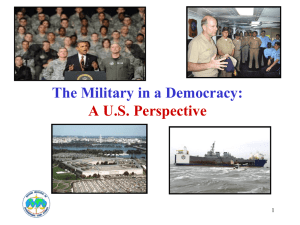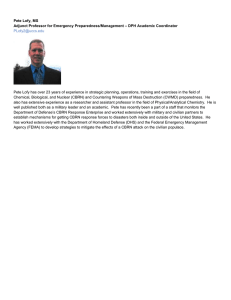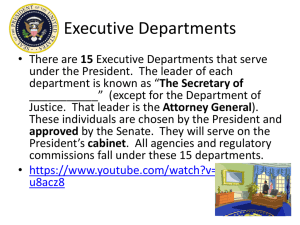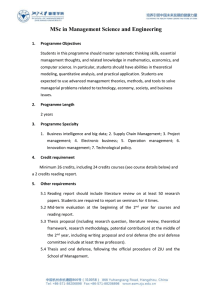Advance Questions for Gen Eberhart
advertisement
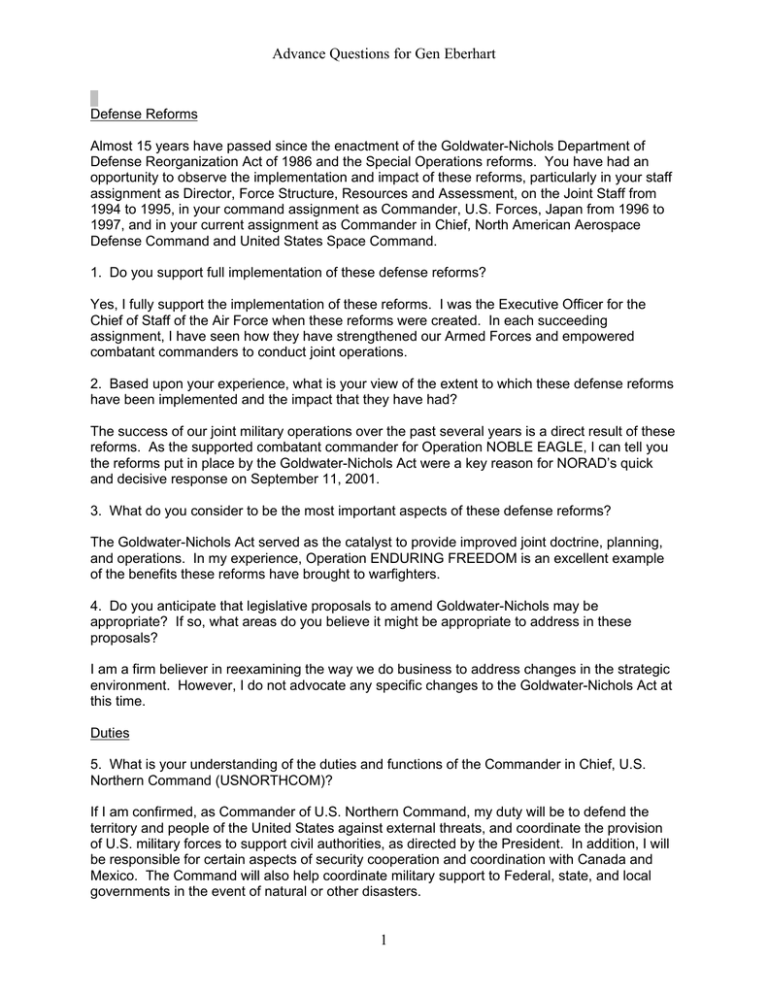
Advance Questions for Gen Eberhart Defense Reforms Almost 15 years have passed since the enactment of the Goldwater-Nichols Department of Defense Reorganization Act of 1986 and the Special Operations reforms. You have had an opportunity to observe the implementation and impact of these reforms, particularly in your staff assignment as Director, Force Structure, Resources and Assessment, on the Joint Staff from 1994 to 1995, in your command assignment as Commander, U.S. Forces, Japan from 1996 to 1997, and in your current assignment as Commander in Chief, North American Aerospace Defense Command and United States Space Command. 1. Do you support full implementation of these defense reforms? Yes, I fully support the implementation of these reforms. I was the Executive Officer for the Chief of Staff of the Air Force when these reforms were created. In each succeeding assignment, I have seen how they have strengthened our Armed Forces and empowered combatant commanders to conduct joint operations. 2. Based upon your experience, what is your view of the extent to which these defense reforms have been implemented and the impact that they have had? The success of our joint military operations over the past several years is a direct result of these reforms. As the supported combatant commander for Operation NOBLE EAGLE, I can tell you the reforms put in place by the Goldwater-Nichols Act were a key reason for NORAD’s quick and decisive response on September 11, 2001. 3. What do you consider to be the most important aspects of these defense reforms? The Goldwater-Nichols Act served as the catalyst to provide improved joint doctrine, planning, and operations. In my experience, Operation ENDURING FREEDOM is an excellent example of the benefits these reforms have brought to warfighters. 4. Do you anticipate that legislative proposals to amend Goldwater-Nichols may be appropriate? If so, what areas do you believe it might be appropriate to address in these proposals? I am a firm believer in reexamining the way we do business to address changes in the strategic environment. However, I do not advocate any specific changes to the Goldwater-Nichols Act at this time. Duties 5. What is your understanding of the duties and functions of the Commander in Chief, U.S. Northern Command (USNORTHCOM)? If I am confirmed, as Commander of U.S. Northern Command, my duty will be to defend the territory and people of the United States against external threats, and coordinate the provision of U.S. military forces to support civil authorities, as directed by the President. In addition, I will be responsible for certain aspects of security cooperation and coordination with Canada and Mexico. The Command will also help coordinate military support to Federal, state, and local governments in the event of natural or other disasters. 1 Advance Questions for Gen Eberhart 6. What background and experience do you possess that you believe qualifies you to perform these duties? More than three decades of military experience, including command positions at the squadron, wing, numbered air force, major, sub-unified, and unified command levels, have provided a solid foundation for assuming the command of USNORTHCOM. In addition, as the Director of Force Structure, Resources and Assessment on the Joint Staff, I gained valuable insights into the dynamics and complexities required of joint operations. As the Vice Chief of Staff of the Air Force, I represented the Department of the Air Force in the Joint Requirements Oversight Council, validating the requirements needed to support warfighting commanders. Finally, as the combatant commander of NORAD and USSPACECOM, I have the honor of leading one of the finest combined and joint teams of soldiers, sailors, airmen and Marines in our military. The performance of these Commands in Operations NOBLE EAGLE and ENDURING FREEDOM best speaks to my qualifications. 7. Do you believe that there are actions you need to take to enhance your ability to perform these duties? If confirmed, I will work every day to prepare myself to assume command on 1 October 2002— and every day thereafter to become a better commander. One can always “enhance his abilities.” That said, as the Commander of NORAD and the co-chair of the USNORTHCOM Integrated Planning Team with GEN Buck Kernan, I believe I am well prepared to assume the duties as Commander, USNORTHCOM. 8. In carrying out your duties, how will you work with the Secretary of Defense, the Chairman of the Joint Chiefs of Staff, the Under Secretary of Defense for Policy, the Assistant Secretary of Defense for Special Operations Forces and Low Intensity Conflict, the Commanders in Chief, U.S. Special Operations Command, U.S. Joint Forces Command, U.S. Space Command, U.S. Strategic Command, and the other combatant commanders? If confirmed, I will continue to work closely with the Secretary. As a combatant commander today, I perform my duties under the authority, direction, and control of the Secretary of Defense. I am directly responsible to him for the preparedness of our two Commands and our ability to carry out assigned missions. The Chairman is not in the chain of command of the combatant commander to the President and the Secretary, however, Title 10 does allow for communications from the combatant commander through the Chairman. This keeps the Chairman informed so that he can execute responsibilities as the principal military advisor to the President and Secretary of Defense. Experience has shown the benefits of the Chairman serving in the role as the President’s and Secretary of Defense’s senior uniformed advisor on military matters, and as the primary military leader through whom combatant commanders can work to perform their missions. If confirmed, I will continue the Title 10 directed relationship, as well as the traditional practices currently in place. The Under Secretaries of Defense coordinate and exchange information with Department of Defense components, to include the combatant commands having related or collateral functions. The majority of Assistant Secretaries are subordinate to one of the Under Secretaries of Defense. Normally, USNORTHCOM’s relationship with any Assistant Secretary will be to work with and through the applicable Under Secretary of Defense. However, when appropriate, we will work directly with the Assistant Secretaries. 2 Advance Questions for Gen Eberhart The relationship of USNORTHCOM to other combatant commanders is one of mutual support, steady dialogue concerning key issues, and frequent interaction. A solid, cooperative, and trusting relationship will enable effective support and execution of US national military strategy. If confirmed, I intend to continue to develop established relationships with the other combatant commanders. 9. In carrying out your duties, how will you work with the Homeland Security Council, the Director of the Office of Homeland Security, the Federal Emergency Management Agency, the Federal Bureau of Investigation and other federal agencies, as well as state and local governments? If confirmed, I will have the same responsibilities and chain of command from the President to the Secretary of Defense as the other combatant commanders. Similarly, USNORTHCOM interagency issues with the Homeland Security Council, the Director of Office of Homeland Security, the FEMA, the FBI, and other Federal agencies will be dealt with through the subordinate element within the Office of the Secretary of Defense assigned responsibility for homeland defense and civil support. Transition Process Since NORTHCOM only exists on paper at this time, a number of issues will have to be resolved between now and October 1 of this year when NORTHCOM is currently scheduled to be established. 10. Would you describe the issues that are presently unresolved, the process that is being followed to resolve these issues, the commands and offices that are involved, and the level at which decisions will be made. The most time-critical issue to be resolved is the Environmental Assessment on the proposed location of the command’s headquarters, which is being worked within Headquarters, United States Air Force. Once completed, the Secretary of Defense will decide site location. Movement of people is on hold, pending the completion of the assessment. Additionally, we are awaiting receipt of FY02 OSD funds to begin the stand-up of the Command. 11. Do all of these issues have to be resolved prior to initial operational capability for NORTHCOM? Yes. We expect the Environmental Assessment to be completed by late June 2002; movement of people will follow. In addition, we are grateful for the Committee’s support of USNORTHCOM funding in the FY03 Defense Emergency Response Fund, and look forward to its release when signed by the President this fall. 3 Advance Questions for Gen Eberhart 12. If not, what issues do you believe have to be resolved on a priority basis, and before NORTHCOM is officially established? Please see answer to #11. USNORTHCOM's Mission 13. What are the definitions of the terms "Homeland Security," "Homeland Defense," "Civil Support," and “Crisis Management?" The Office of Homeland Security has provisionally defined homeland security as “ a concerted national effort to prevent terrorist attacks within the United States, reduce America’s vulnerability to terrorism, and minimize the damage and recover from attacks should they occur.” With its focus on the prevention of and response to terrorist attacks, this is a different focus than the Department of Defense’s long-standing mission and highest priority – to defend the United States from all enemies. Homeland defense is defined as the protection of U.S. sovereignty, territory, domestic population, and critical defense infrastructure against external threats and aggression. Civil support is the Department of Defense’s assistance to civil authorities for domestic emergencies and other designated activities. Some civil support activities relate to homeland security (e.g., consequence management support in the event of a terrorist CBRNE incident), although the full range of civil support provided by the Department of Defense includes a broader range of activities (e.g., natural disasters). Crisis management is taking measures to identify, acquire, and plan the use of resources needed to anticipate, prevent, and resolve a threat or act of terrorism. 14. What is the mission of USNORTHCOM? USNORTHCOM will conduct operations to deter, prevent, preempt, and defeat threats and aggression aimed at the United States of America and its territories, within the assigned area of responsibility. When directed by the President or Secretary of Defense, it will also provide military assistance to civil authorities, including consequence management operations, in order to protect and defend the United States. 15. How does USNORTHCOM's mission relate to the U.S. Government's Homeland Security mission? Please see #13 and #14 above. 16. How does USNORTHCOM's mission relate to the Department of Defense's efforts to combat terrorism? Similar to the other geographic combatant commanders, USNORTHCOM will combat terrorism through force protection measures, and by employing forces at the direction of the President to stop terrorist operations. In addition, USNORTHCOM’s anti-terrorism and consequence management activities will help reduce the vulnerability of our people and property against terrorists who threaten the United States of America and its territories. 4 Advance Questions for Gen Eberhart 17. Do you anticipate that USNORTHCOM will have a continuity of government role to play? As directed by the Secretary of Defense, USNORTHCOM would assist in the continuity programs of the Department of Defense. 18. Under what circumstances would you anticipate USNORTHCOM would have the lead role, rather than the role of supporting civil authorities? USNORTHCOM would have the lead role under extraordinary circumstances that require the Department of Defense to execute its traditional military missions in response to an attack on or threat to North America. Combat air patrols and maritime defense operations are examples of these missions. Organization and Authority 19. Do you anticipate that NORTHCOM will have the component commands that are traditionally assigned to combatant commands? The final organizational structure of USNORTHCOM has not been determined—it is currently under review. The Implementation Planning Team is looking at options with and without component commands. 20. Do you anticipate that NORTHCOM's staff will be organized along the lines of the traditional combatant command staff? USNORTHCOM’s final staff structure is still being developed. The Implementation Planning Team is assessing options based on transformational concepts, such as Standing Joint Force Headquarters, as well as traditional models. 21. Do you anticipate that substantial air, land and maritime forces will be assigned to NORTHCOM and, if confirmed, under your combatant command, or will such forces only be under your operational control? If confirmed, I do not anticipate a large number of operational forces being assigned to USNORTHCOM. Whether specific forces will be assigned or placed under operational control of USNORTHCOM is still to be determined. I am confident that, when required, trained and ready forces will be provided to execute assigned missions in USNORTHCOM’s area of responsibility. 22. If such forces are only under your operational control, how will you ensure their readiness to perform the assigned missions and tasks? Just as the other geographic combatant commands do, USNORTHCOM will coordinate with unified commands and the Military Departments to establish appropriate training and readiness objectives for forces required to execute military operations. USJFCOM will be the primary joint force provider for USNORTHCOM; the Military Departments will certify these forces are mission-ready. USJFCOM already plays a vital role in preparing battle-ready forces for combatant commanders. 23. Since Alaskan Command Forces will remain assigned to U.S. Pacific Command, what impact will that have on NORTHCOM's mission? 5 Advance Questions for Gen Eberhart The force projection and deterrence capabilities of Alaskan Command will add another dimension to USNORTHCOM’s mission. Additionally, although these forces will be assigned to USPACOM, they will be made available to USNORTHCOM, if directed by the Secretary of Defense. This is a relationship that works and I use every day as Commander of NORAD. 24. Do you anticipate being able to employ forces within the continental United States, or will you have to obtain the approval of higher authority before their employment? Within the Continental United States, employment of forces will be preceded by a specific request and appropriate authorization from the President or the Secretary of Defense under existing guidelines. Routine training and exercise deployments of forces within a command’s area of responsibility do not require approval from higher authority. 25. Do you anticipate that the Army's Directorate of Military Support (DOMS) will continue to be involved in the employment of forces for tasks such as disaster relief? Yes, I believe the functions accomplished by DOMS will continue to be critical in planning, organizing, and coordinating support to civil authorities. 26. Currently, SPACECOM is responsible for both offensive and defensive computer network operations (information operations). In your view, what elements, if any, of this information operation/information assurance mission should be reassigned to NORTHCOM? USNORTHCOM, like the other geographic combatant commands, will retain responsibility for information operations and information assurance related to its mission within its assigned area of responsibility. NORAD and JTF-CS Organizations existing within other commands will be transferred to NORTHCOM, including the North American Aerospace Defense Command (NORAD) and the Joint Task Force - Civil Support (JTF-CS). NORAD, which is currently under your command, will be transferred from U.S. Space Command to NORTHCOM. As you already stated to the Committee in February, the transition requires negotiation with Canada. 27. What, if anything, do you recommend be altered in the current NORAD agreement between the U.S. and Canada? NORAD and USSPACECOM are two separate organizations that share a common commander and some supporting staff elements. Each Command stands on its own with respect to the conduct of its operations. As such, there is no need to amend the current NORAD Agreement; NORAD’s bi-national mission will continue, regardless of the stand-up of USNORTHCOM. 6 Advance Questions for Gen Eberhart 28. When NORAD moves under NORTHCOM, how will NORTHCOM and SPACECOM coordinate activities and common facilities? NORAD will not move under USNORTHCOM. Due to its unique nature as a bi-national command, NORAD will not become subordinate to USNORTHCOM, which will be a US-only command. USNORTHCOM will coordinate activities and any shared facilities with USSPACECOM. 29. Will there be any impact on NORAD and coordination of early warning systems as a result of the move from SPACECOM? USSPACECOM will continue to support NORAD, as well as other combatant commands, by providing integrated tactical warning and attack assessment for North America. The split of currently shared NORAD and USSPACECOM support staffs will have no impact on early warning systems. 30. Does the move of NORAD from SPACECOM signal the end of SPACECOM? No, USSPACECOM will continue to perform its Unified Command Plan (UCP)-assigned missions until such time as the Secretary of Defense recommends, and the President approves, a modification to the UCP that changes assigned missions or combines missions with another command. 31. If confirmed, what changes, if any, would you make to the mission, organization, location or staffing of JTF-CS? I do not have any specific recommendations regarding the JTF-CS at this time. At the present time, various units with responsibilities relating to the counter-drug mission, including Joint Interagency Task Force-East, Joint Interagency Task Force-West, and Joint Task Force-Six are assigned to the several combatant commanders. 32. Do you anticipate that any of those units will be assigned to NORTHCOM? While a final determination is yet to be made, the USNORTHCOM Terms of Reference specify only Joint Task Force-Six will be assigned to USNORTHCOM on 1 October 2002. 33. How will NORTHCOM's mission relate to the U.S. Government's counter-drug mission and organization? Through JTF-6 (currently assigned to USJFCOM), USNORTHCOM may provide the Department of Defense’s counter-drug support to Federal, regional, state, and local law enforcement agencies throughout the Continental United States. This option is currently under review. 7 Advance Questions for Gen Eberhart 34. What additional actions have you taken in NORAD since September 11th to mitigate force protection vulnerability, and what new force protection challenges do you anticipate you will encounter within USNORTHCOM's area of responsibility, if confirmed? Since September 11th, NORAD has worked with the Military Departments to implement increased security measures at facilities and alert locations throughout the Command. If confirmed, I anticipate the biggest force protection challenge will be coordinating with USJFCOM and the Military Departments to ensure the appropriate force protection condition for the area of responsibility. National Guard There is currently considerable debate about the role the National Guard should play in defending the homeland. 35. What do you anticipate the relationship will be between NORTHCOM and the National Guard Bureau and individual state National Guard headquarters? USNORTHCOM’s relationship with the National Guard Bureau and individual state National Guard headquarters is currently under review. The National Guard will be key to USNORTHCOM successfully accomplishing its assigned mission. 36. What type of liaison arrangements do you advocate between NORTHCOM, first responders and state National Guard units for planning and operational purposes? USNORTHCOM will have responsibility (when directed) to provide military assistance to U.S. civil authorities who are designated as lead federal agencies. USNORTHCOM will have direct communication with National Guard units for planning purposes, and will maintain situational awareness of National Guard actions and commitments. If they are mobilized under Title 10 status, the Commander, USNORTHCOM, may have direct tasking authority of these units, depending on the mission. 37. Do you believe that defending the homeland should become the National Guard's primary mission? I believe defending the homeland is the highest priority mission for our Armed Forces—Active, Guard, and Reserve. The National Guard can support homeland security in several ways; first, in state service under the direction of the governors. For example, on September 11, the National Guard of New York, New Jersey and Connecticut responded to the attacks on the World Trade Center towers. Second, in state service but performing duties of federal interest, is the so-called Title 32 status. This is primarily designed to compensate guardsmen for federal training, but most recently it was used also to support patrols in over 400 airports across the country. Third, in federal service, the so-called Title X status, when for example, the National Guard is mobilized to serve under the direction of the President or the Secretary of Defense. These arrangements have worked well in the past. The challenge today is to translate them into our new security environment. There are many proposals for doing so, and we understand the Department of Defense will work with the Congress, the National Guard Bureau, the governors, and the Office of Homeland Security to make certain that we all have an approach that meets the Nation's needs. 8 Advance Questions for Gen Eberhart 38. To the extent that the National Guard is involved in homeland defense missions, and given the constraints of the posse comitatus law, what status should the National Guard have (i.e. title 10, United States Code; title 32, United States Code; or State status) in conducting such missions? The specific status of National Guard units for a given scenario will be situation dependent. This is not a constraint, as there is the ability to move specific National Guard units between Title 10 and Title 32 and state status as needed by the mission. 39. Do you believe changes to the Posse Comitatus law are necessary to enhance NORTHCOM's mission accomplishment? No. USNORTHCOM’s mission of military support to civil authorities does not require any changes in the law. While the Command may provide military forces under Title 10 to assist civilian agencies, these forces will not be directly involved in civilian law enforcement, unless authorized by law to engage in law enforcement activities. Combat Air Patrols The administration recently announced that it would scale back the combat air patrols over Washington, New York and other cities, which have been conducted on a regular basis since September 11, 2001. 40. Do you believe that a change in the combat air patrol mission is warranted? Yes, I believe a change to the number of combat air patrols is warranted due to several factors: improvements in aviation security at airports, more rigorous air marshal program, stronger cockpit doors, better interagency cooperation, increased awareness from the traveling public, and expanded radar and radio coverage within the US. 41. If confirmed, what criteria would you use to determine combat air patrol frequency, duration and location? The nature of a threat, number and location of sites to be protected, reaction time of groundalert aircraft, US Secret Service requirements, weather, and the need to be unpredictable to the enemy all factor into any decision. Weapons of Mass Destruction - Civil Support Teams 42. There are currently 32 authorized Weapons of Mass Destruction – Civil Support Teams. When all of these teams are stood up, they will cover approximately 97 percent of the U.S. population. It is our understanding that the Department is currently reviewing the mission, doctrine, organization, and equipping of the teams. Do you believe that the teams need more robust capabilities to not only detect, but also to decontaminate or manage the response to a WMD attack? The structure, resources and locations of Civil Support Teams appear to be sufficient, given today’s threat levels. Twenty-seven of these teams are currently certified, with five more undergoing the qualification process. The Civil Support Teams are vital to consequence management, and it will be important to continue modernization of their capabilities as future technology and threats develop. 9 Advance Questions for Gen Eberhart 43. Do you believe that the mission for the teams should change? Has the requirement changed? Should there be more teams? I am aware that the Department of Defense is studying current and future chemical and biological threats, and the force structure of the Civil Support Teams. If it is determined that there may be an increased risk of attacks, it would be appropriate to reconsider the mission, numbers and structure of the Civil Support Teams. Transfer of Responsibility Various areas that are presently under U.S. Southern Command's (SOUTHCOM's) area of responsibility, including the Gulf of Mexico, Puerto Rico, the Virgin Islands, Cuba, the Bahamas, and the Turks and Caicos Islands, will be transferred to NORTHCOM's area of responsibility. 44. What are the major challenges that will be involved in the process of transferring these areas to NORTHCOM's responsibility? I do not foresee any major challenges. USSOUTHCOM will retain the responsibility for contingency planning, operations, theater security cooperation, and force protection. 45. Do you foresee a transfer of responsibility for all of those areas on October 1, 2002 and, if so, are you confident that the transfer can be accomplished without adverse impact by that date? If confirmed, I will work closely with the USSOUTHCOM Commander to ensure a smooth transfer of responsibilities. Although Cuba, the Bahamas, and the Turks and Caicos Islands will be transferred to NORTHCOM's area of responsibility, SOUTHCOM will retain responsibility for normal and contingency planning, theater security cooperation, and force protection for those areas. 46. In view of the responsibility retained by SOUTHCOM, what responsibility will NORTHCOM have with respect to these countries? USNORTHCOM is responsible for deterring and defending against threats that may be emanating from or through these geographic areas. Under the new UCP, these areas were placed in USNORTHCOM’s area of responsibility because of their proximity to the Continental United States. However, USSOUTHCOM will retain its responsibilities as outlined above in #44. With the transition of U.S. Joint Forces Command from a regional to a functional unified command, there is a need to designate another commander as Supreme Allied Commander, Atlantic (SACLANT). 47. In view of the transfer of part of Joint Forces Command's geographic area of responsibility, including part of the North Atlantic Ocean, to NORTHCOM, do you believe that, if confirmed, you should be dual-hatted as SACLANT? No. USNORTHCOM will only gain responsibility for the portion of USJFCOM’s maritime Area of Responsibility that covers “approaches to” the US and is tied to the maritime defense of the US. The remainder of the areas currently assigned to USJFCOM in the eastern Atlantic will transfer to USEUCOM. The assignment of SACLANT and its responsibilities is a matter for decision by the members of NATO. 10 Advance Questions for Gen Eberhart Mexico Mexico, which has never before been included within the area of responsibility of a combatant commander, will also be included in NORTHCOM's area of responsibility. Among other things, NORTHCOM will be responsible for security cooperation and military coordination with Mexico. 48. What does such security cooperation and military coordination entail? These activities could include senior officer visits, security assistance (foreign military sales, international training) and combined exercises. 49. Do you anticipate that Mexico could be involved in contingency planning for defense of the continent? USNORTHCOM will develop plans for the defense of all approaches—air, land and maritime— to the US. When appropriate and when authorized, it will coordinate with Mexico and Canada to ensure the defense of the continent. 50. What, if any, involvement could Mexico have in NORAD? Mexico has no involvement in NORAD under the current NORAD Agreement between the US and Canada. Any participation would require a revision to the agreement, and approval by all three countries. Unified Command Plan A review of the next Unified Command Plan is reportedly underway or imminent. This review will reportedly include consideration of merging U.S. Space Command with U.S. Strategic Command and establishing a hemispheric U.S. Americas Command combining NORTHCOM and SOUTHCOM. 51. What do you believe are the advantages and disadvantages of each of these two proposals? The Unified Command Plan is the purview of the Secretary of Defense and the President—to recommend and approve, respectively. As shown by the recent changes, it is periodically reviewed to ensure the best defense posture for our Nation. While I believe the alternatives you suggest certainly warrant consideration, it is inappropriate for me to speculate on future changes. Congressional Oversight In order to exercise its legislative and oversight responsibilities, it is important that this Committee and other appropriate committees of the Congress are able to receive testimony, briefings, and other communications of information. 52. Do you agree, if confirmed for this high position, to appear before this Committee and other appropriate committees of the Congress? Yes. 11 Advance Questions for Gen Eberhart 53. Do you agree, when asked, to give your personal views, even if those views differ from the administration in power? Yes. 54. Do you agree, if confirmed, to appear before this Committee, or designated members of this Committee, and provide information, subject to appropriate and necessary security protection, with respect to your responsibilities as the CINCNORTH? Yes. 55. Do you agree to ensure that testimony, briefings and other communications of information are provided to this Committee and its staff and other appropriate committees? Yes. 12
